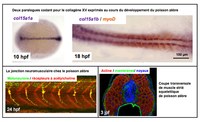Thesis: Emilie GUILLON
Emilie GUILLON from team of Florence RUGGIERO (Matrix biology and pathology) will defend her thesis (in french) entitled:
"Etude fonctionnelle du collagène XV-B dans le développement du système neuromusculaire du poisson zèbre"
This event is scheduled for July 10 at 02:00PM at the amphitheater SVT (ENS, Monod campus)
Abstract:
After exiting the spinal cord, motor axons follow a stereotyped path toward their muscle target guided by multiple directional cues. Besides classic guidance molecules, the extracellular matrix provides positional information to guide motoneuron axons along their appropriate paths. Recent evidence shows that collagens play important roles in neuromuscular development. Collagen XV (COLXV) is a basement membrane associated component that is encoded in zebrafish by two paralogs. My laboratory previously reported that col15a1a expression was restricted to notochord and that this paralog contributed to muscle development by interplaying with Hedgehog signaling.

click on the image to enlarge it.
My PhD project consisted in the characterization of the expression pattern of the col15a1b paralog during development and in the analysis of the in vivo function of this paralog in developing zebrafish embryos. Interestingly, using in situ hybridization, we showed that col15a1b is transiently and specifically expressed in the developing trunk by slow fiber precursors, the adaxial cells by the time of their differentiation into slow fibers. Adaxial cells represent an important source of the extracellular matrix path in which motor axons navigate. Therefore we next decided to interrogate the function of col15a1b during development of zebrafish neuromuscular system.Immunofluorescence co-staining with newly generated antibodies to COLXV-B and cell-type specific markers indicated that COLXV-B paves the initial common trajectory of motor axons prior to axonal extension and persisted there by the time of axon progression. Overexpression of dominant-negative PKA in wild-type embryos and immunodetection of COLXV-B in unplugged mutants showed that col15a1b expression depends on Hedgehog signaling whereas the critical organization of COLXV-B at the motor path depends upon unplugged/MuSK gene activity. Pertinent to its expression in adaxial cells and location at the common path, morpholino-based knockdown of col15a1b compromised adaxial cell differentiation by increasing the number of muscle pioneers and caused primary motoneuron axons to stall abnormally at the choice point where specific pathway selection takes place. Absence of the protein in the common path later provoked secondary axon truncation or pathfinding errors at the choice point. As a consequence of disrupted muscle innervation, col15a1b-morphants exhibited significant muscle fiber atrophy and compromised swimming behavior in response to touch stimulation. Our data identified an unexpected role for COLXV-B as an unplugged/MuSK-dependent cue that paves the axonal motor path to guide the decision of axons at the choice point. The conserved syntheny, the broad expression pattern of col15a1b similar to COL15A1 ortholog and the conservation of the primary sequence of COLXV-B with the mammalian counterparts suggested that the human protein COLXV could display similar function and represent a gene candidate for neuromuscular disorders.
Key words: Extracellular matrix; Zebrafish; Muscle precursors; Axonal guidance; Signaling.



